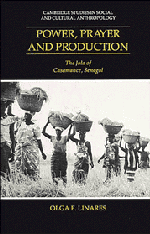Book contents
- Frontmatter
- Contents
- List of illustrations
- List of tables
- Acknowledgements
- Note on orthography
- INTRODUCTION: IDEOLOGY AND AGRARIAN CHANGE
- PART I THE POLITICAL ECONOMY OF SAMBUJAT
- Chapter 1 The power of the spirit-shrines
- Chapter 2 Rice fields and labor relationships
- Conclusions to Part I
- PART II AT THE CROSSROADS: THE KUJAMAAT JOLA OF JIPALOM
- PART III MANDING MODELS AND FATIYA MORES
- EPILOGUE: THE JOLA IN THE PRESENT NATIONAL SCENE
- Notes
- References
- Index
- Cambridge Studies in Social and Cultural Anthropology
Conclusions to Part I
Published online by Cambridge University Press: 04 November 2009
- Frontmatter
- Contents
- List of illustrations
- List of tables
- Acknowledgements
- Note on orthography
- INTRODUCTION: IDEOLOGY AND AGRARIAN CHANGE
- PART I THE POLITICAL ECONOMY OF SAMBUJAT
- Chapter 1 The power of the spirit-shrines
- Chapter 2 Rice fields and labor relationships
- Conclusions to Part I
- PART II AT THE CROSSROADS: THE KUJAMAAT JOLA OF JIPALOM
- PART III MANDING MODELS AND FATIYA MORES
- EPILOGUE: THE JOLA IN THE PRESENT NATIONAL SCENE
- Notes
- References
- Index
- Cambridge Studies in Social and Cultural Anthropology
Summary
“The study of human life, Marx emphasises, is the study of definite social practices, geared into human needs” (Giddens 1979: 151). Surely, however, the study of human life is more than this. It is also the analysis of cultural symbols and ideologies through which members of a specific society perceive their surroundings and organize themselves to act upon it. These are as much a part of the forces of production equation as are tools and know-how, for they mobilize people to perform essential tasks.
Sambujat's rice-growing system is both labor-intensive and highly routinized. Once the appropriate strategy is chosen to accommodate particular weather conditions, the same tasks are repeated day after day until a stage in the cycle, say field preparation or transplanting, is completed. Not surprising, the inhabitants take their work very seriously. In itself, work is socially meaningful. It labels a person as being an aroka (a “hard,” “real” worker). Someone who is puteput (rotted, decomposed) is lazy. The Jola have a proverb: “To be sitting is never to one's advantage” (from Thomas 1959: 423; quoted in Baum 1987: 405). What Bourdieu (1977:175) says of the Kabyle is also true of the Jola of Sambujat: “Activity is as much a duty of communal life as an economic necessity.” However, it is not activity per se but the cultural constructs through which social ontrol is exerted, the corporate tasks through which the labor process unfolds, the collective symbols through which it is organized, the mystical forces through which it is maintained, that gives the Sambujat system its very particular cast.
- Type
- Chapter
- Information
- Power, Prayer and ProductionThe Jola of Casamance, Senegal, pp. 74 - 80Publisher: Cambridge University PressPrint publication year: 1991

